After years of wrangling, missed deadlines and theatrics in the House of Commons, Brexit finally happened last year as the UK formally exited the EU on 31 December 2020.
The last-minute negotiations between Brussels and London ran right up to Christmas Eve but a deal was struck in the end.
Yet, despite both sides reaching agreement on a bare-bones trade deal, it has been long flagged by business groups, particularly those in the food industry, that Brexit was going to mean very significant changes to the efficiency of supply chains between the UK and Europe.
As the Brexit trade deal began to take shape under Boris Johnson and it became clear that the UK was leaving the EU’s single market, the re-introduction of red tape on the trade of food and products of animal origin became inevitable.
Cost of doing business
In Ireland, the agri-food industry warned of a significant increase in the cost of doing business for beef and cheese exporters to the UK due to the increased paperwork required for animal health certificates and SPS checks.
In reverse, Brexit meant a lot more compliance paperwork on all imports of British-made and processed foods coming into Ireland.
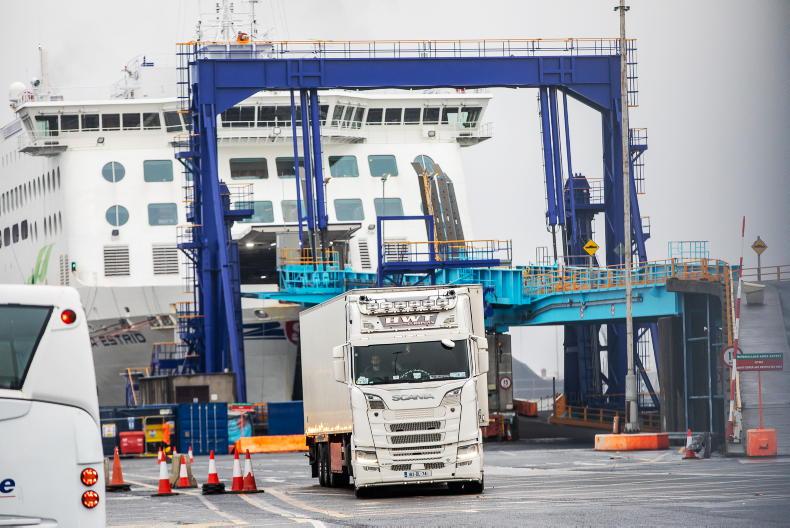
Dublin Port as restrictions on travel from the UK were announced due to a new variant of COVID-19. In the same week, UK and EU Brexit negotiations come down to the wire. \ Philip Doyle
Oddly, it was not sausages, beef or cheese which characterised the post-Brexit confusion for food exports between the UK and Ireland. Instead, the popular Percy Pig sweets sold by Marks & Spencer (M&S) became one of the first casualties of Brexit and illustrated the complexity of modern supply chains.
Red tape
It soon emerged that the iconic Percy Pig sweets are made in Germany, imported to the UK and then re-distributed from there to the M&S network of stores, including those in Ireland.
This meant any product being shipped to Ireland by M&S was classified as an export from the UK to Ireland and, crucially, lost its country-of-origin status for free trade between EU member states.
The loss of its country-of-origin status meant these products were now subject to a whole raft of paperwork and even import taxes.
Unsurprisingly, M&S stores in Ireland went without the beloved Percy Pig sweets for many weeks as the retailer untangled the complexities of its supply chain.
While Percy Pig made the headlines, the same problems were being experienced right across the food supply chain between the UK and Ireland for a number of products that moved along similar supply chains.

Dublin Port. \ Philip Doyle
For Malachy O’Connor, a well-known consultant in the grocery retail sector having worked for over 20 years in key commercial roles with Tesco Ireland and Aldi Ireland, the supply chain disruption caused by Brexit came as no surprise.
“I remember giving a presentation in January 2019 at a conference for FMCG brand owners where I warned that Brexit was going to mean serious turbulence for supermarket supply chains.
“It was obvious because so much of the food that ends up on Irish supermarket shelves is coming from or travelling through the UK,” says O’Connor.
“If you think about it, these major food companies have large supply depots in the UK where they import all their food to service the UK and Ireland as a single geography. They then break down these consignments and start distributing product to their network of stores in the UK and Ireland. It was really efficient but it was set up for seamless movement of product,” he adds.
Now that Brexit has happened, that seamless movement of goods has come to an end for every company trying to move goods across the Irish Sea.
“Food supply chains between the UK and Ireland were so finely tuned it was incredible. There was never an empty container moving back and forth,” says O’Connor.
“But now there’s going to have to be a realignment of supply chains. There will be a significant increase in direct shipping to Ireland of EU goods from now on, which is going to add cost and be less efficient,” he says.
Major companies
“You actually have a scenario now where a lot of major companies are looking at Ireland and asking themselves can they afford to supply the Irish market. It’s a small country on the edge of Europe that has a population the same size as Manchester so the cost of realigning supply chains may not be worth it for some companies,” warns O’Connor.
While it may just be a short-term shortage, O’Connor says you can already see shortages of certain product lines on Irish shelves for a variety of reasons including Brexit.
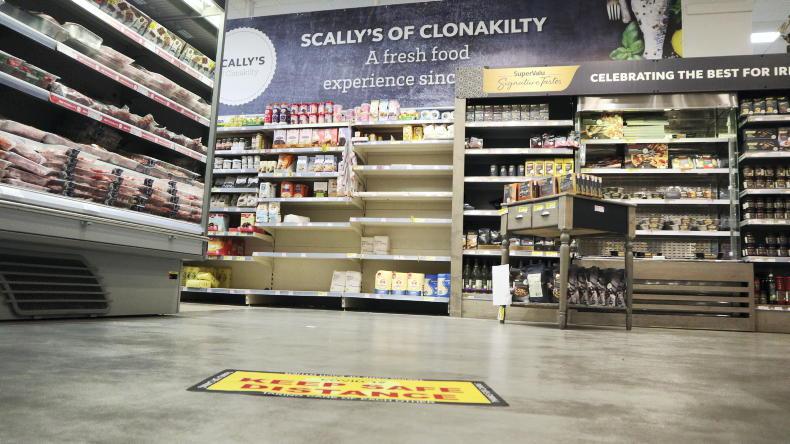
Since the start of the year, he says food items such as berries, pulses and nuts have been in short supply, while there has also been less availability of pet food and bin bags.
On the pet food shortages, O’Connor says this is mostly down to COVID-19 with pet ownership, particularly dogs, exploding in the last year. The sharp increase in household pets has seen a surge in demand for pet food, which the industry has struggled to keep pace with.
There was price inflation of 3% last year as consumers were buying more brands
But what other trends has O’Connor noticed in the supermarket aisles over the last year related to COVID-19?
“There was price inflation of 3% last year as consumers were buying more brands last year.
It was also noticeable that a lot of food companies cut the number of products they sell to focus on their core lines. This collaboration between retailers and suppliers was essential to meet the surge in demand.
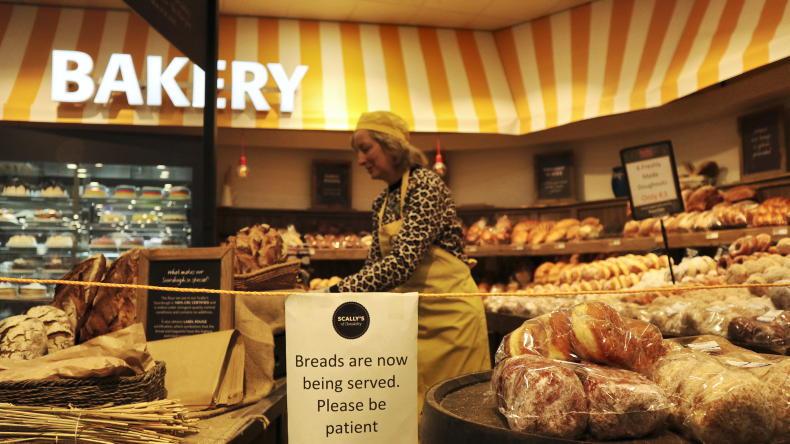
The fall in the price of food over the last decade was not driven by consumers. Instead, it was driven by the supermarkets themselves.
“Alongside this, you could also see food companies bringing out bigger packs for their products because consumers were buying larger volumes,” he says.
The other really interesting trend in the supermarket sector over the last year, says O’Connor, was the growth in online.
“Online grocery shopping effectively doubled last year in Ireland, although it’s still quite small overall as it went from less than 3% to just 5.4% of the entire market last year.
“So it’s growing but we’re still way behind the UK in terms on online grocery where about 15% of grocery shopping is now done online,” he says.
Unlike in the UK, Ireland has a low-density population outside the cities, which is hard to service with online
Prior to COVID-19, O’Connor says Tesco Ireland and SuperValu were the only two supermarkets in Ireland taking online grocery shopping seriously. However, the pandemic forced the other major players to try to catch up.
Lidl had been working with Buymie since 2018, giving it a head start on Dunnes Stores, which is now also working with Buymie, and Aldi, which has partnered with Deliveroo. However, O’Connor remains to be convinced about online grocery and how big a feature it will be of the Irish grocery market after COVID-19.
“I carried out some research recently which tells me that in-store shopping is still what most Irish consumers prefer. So I’m not sure how seriously the Irish supermarkets are taking online shopping.
“Unlike in the UK, Ireland has a low-density population outside the cities, which is hard to service with online,” he adds.
The COVID-19 pandemic has meant consumers were never more reliant on their local supermarket in order to eat.
Before the virus hit, almost 50c in every euro spent on food in Ireland was done in a restaurant or food service outlet, meaning Irish consumers were eating out more than ever.
So what does this mean for the future of the sector? O’Connor says it will be interesting to watch how society reacts after the vaccine rollout.
He says supermarkets will continue to do well after COVID-19 but says there’s definitely a real sense of cooking fatigue among consumers right now.
Online grocery shopping doubled last year in Ireland
In the longer term, O’Connor says it will be interesting to watch how supermarkets react to the sustainability agenda. There’s already a lot going on in terms of plastic packaging and food waste, but he says the price of food has fallen to a level that’s too low.
“The fall in the price of food over the last decade was not driven by consumers. Instead, it was driven by the supermarkets themselves. Originally, this was by the big retailers trying to stem loss of sales to the discounters but sustained by them all in the battle to win market share.
“Unfortunately I think it has skewed consumer understanding of the cost of food, especially for local produce. And now it’s actually really difficult to have food price inflation because of the competition,” says O’Connor.
Against the backdrop of growing consumer awareness about sustainability and the carbon footprint of food, it will be fascinating to watch how the supermarkets compete with one and other over the coming decade.
Added to that, the increased costs of realigning supply chains might mean a return to food price inflation in Ireland over the coming years.
Or will the intense rivalry for market share between the big five retailers in Ireland mean food prices are set to stay rock bottom? Time will tell.
Brexit has disrupted supermarket supply chains.Surge in demand for pet food as pet ownership increased with COVID-19.Food price is too low, driven not by consumers but by supermarkets themselves.
After years of wrangling, missed deadlines and theatrics in the House of Commons, Brexit finally happened last year as the UK formally exited the EU on 31 December 2020.
The last-minute negotiations between Brussels and London ran right up to Christmas Eve but a deal was struck in the end.
Yet, despite both sides reaching agreement on a bare-bones trade deal, it has been long flagged by business groups, particularly those in the food industry, that Brexit was going to mean very significant changes to the efficiency of supply chains between the UK and Europe.
As the Brexit trade deal began to take shape under Boris Johnson and it became clear that the UK was leaving the EU’s single market, the re-introduction of red tape on the trade of food and products of animal origin became inevitable.
Cost of doing business
In Ireland, the agri-food industry warned of a significant increase in the cost of doing business for beef and cheese exporters to the UK due to the increased paperwork required for animal health certificates and SPS checks.
In reverse, Brexit meant a lot more compliance paperwork on all imports of British-made and processed foods coming into Ireland.

Dublin Port as restrictions on travel from the UK were announced due to a new variant of COVID-19. In the same week, UK and EU Brexit negotiations come down to the wire. \ Philip Doyle
Oddly, it was not sausages, beef or cheese which characterised the post-Brexit confusion for food exports between the UK and Ireland. Instead, the popular Percy Pig sweets sold by Marks & Spencer (M&S) became one of the first casualties of Brexit and illustrated the complexity of modern supply chains.
Red tape
It soon emerged that the iconic Percy Pig sweets are made in Germany, imported to the UK and then re-distributed from there to the M&S network of stores, including those in Ireland.
This meant any product being shipped to Ireland by M&S was classified as an export from the UK to Ireland and, crucially, lost its country-of-origin status for free trade between EU member states.
The loss of its country-of-origin status meant these products were now subject to a whole raft of paperwork and even import taxes.
Unsurprisingly, M&S stores in Ireland went without the beloved Percy Pig sweets for many weeks as the retailer untangled the complexities of its supply chain.
While Percy Pig made the headlines, the same problems were being experienced right across the food supply chain between the UK and Ireland for a number of products that moved along similar supply chains.

Dublin Port. \ Philip Doyle
For Malachy O’Connor, a well-known consultant in the grocery retail sector having worked for over 20 years in key commercial roles with Tesco Ireland and Aldi Ireland, the supply chain disruption caused by Brexit came as no surprise.
“I remember giving a presentation in January 2019 at a conference for FMCG brand owners where I warned that Brexit was going to mean serious turbulence for supermarket supply chains.
“It was obvious because so much of the food that ends up on Irish supermarket shelves is coming from or travelling through the UK,” says O’Connor.
“If you think about it, these major food companies have large supply depots in the UK where they import all their food to service the UK and Ireland as a single geography. They then break down these consignments and start distributing product to their network of stores in the UK and Ireland. It was really efficient but it was set up for seamless movement of product,” he adds.
Now that Brexit has happened, that seamless movement of goods has come to an end for every company trying to move goods across the Irish Sea.
“Food supply chains between the UK and Ireland were so finely tuned it was incredible. There was never an empty container moving back and forth,” says O’Connor.
“But now there’s going to have to be a realignment of supply chains. There will be a significant increase in direct shipping to Ireland of EU goods from now on, which is going to add cost and be less efficient,” he says.
Major companies
“You actually have a scenario now where a lot of major companies are looking at Ireland and asking themselves can they afford to supply the Irish market. It’s a small country on the edge of Europe that has a population the same size as Manchester so the cost of realigning supply chains may not be worth it for some companies,” warns O’Connor.
While it may just be a short-term shortage, O’Connor says you can already see shortages of certain product lines on Irish shelves for a variety of reasons including Brexit.

Since the start of the year, he says food items such as berries, pulses and nuts have been in short supply, while there has also been less availability of pet food and bin bags.
On the pet food shortages, O’Connor says this is mostly down to COVID-19 with pet ownership, particularly dogs, exploding in the last year. The sharp increase in household pets has seen a surge in demand for pet food, which the industry has struggled to keep pace with.
There was price inflation of 3% last year as consumers were buying more brands
But what other trends has O’Connor noticed in the supermarket aisles over the last year related to COVID-19?
“There was price inflation of 3% last year as consumers were buying more brands last year.
It was also noticeable that a lot of food companies cut the number of products they sell to focus on their core lines. This collaboration between retailers and suppliers was essential to meet the surge in demand.

The fall in the price of food over the last decade was not driven by consumers. Instead, it was driven by the supermarkets themselves.
“Alongside this, you could also see food companies bringing out bigger packs for their products because consumers were buying larger volumes,” he says.
The other really interesting trend in the supermarket sector over the last year, says O’Connor, was the growth in online.
“Online grocery shopping effectively doubled last year in Ireland, although it’s still quite small overall as it went from less than 3% to just 5.4% of the entire market last year.
“So it’s growing but we’re still way behind the UK in terms on online grocery where about 15% of grocery shopping is now done online,” he says.
Unlike in the UK, Ireland has a low-density population outside the cities, which is hard to service with online
Prior to COVID-19, O’Connor says Tesco Ireland and SuperValu were the only two supermarkets in Ireland taking online grocery shopping seriously. However, the pandemic forced the other major players to try to catch up.
Lidl had been working with Buymie since 2018, giving it a head start on Dunnes Stores, which is now also working with Buymie, and Aldi, which has partnered with Deliveroo. However, O’Connor remains to be convinced about online grocery and how big a feature it will be of the Irish grocery market after COVID-19.
“I carried out some research recently which tells me that in-store shopping is still what most Irish consumers prefer. So I’m not sure how seriously the Irish supermarkets are taking online shopping.
“Unlike in the UK, Ireland has a low-density population outside the cities, which is hard to service with online,” he adds.
The COVID-19 pandemic has meant consumers were never more reliant on their local supermarket in order to eat.
Before the virus hit, almost 50c in every euro spent on food in Ireland was done in a restaurant or food service outlet, meaning Irish consumers were eating out more than ever.
So what does this mean for the future of the sector? O’Connor says it will be interesting to watch how society reacts after the vaccine rollout.
He says supermarkets will continue to do well after COVID-19 but says there’s definitely a real sense of cooking fatigue among consumers right now.
Online grocery shopping doubled last year in Ireland
In the longer term, O’Connor says it will be interesting to watch how supermarkets react to the sustainability agenda. There’s already a lot going on in terms of plastic packaging and food waste, but he says the price of food has fallen to a level that’s too low.
“The fall in the price of food over the last decade was not driven by consumers. Instead, it was driven by the supermarkets themselves. Originally, this was by the big retailers trying to stem loss of sales to the discounters but sustained by them all in the battle to win market share.
“Unfortunately I think it has skewed consumer understanding of the cost of food, especially for local produce. And now it’s actually really difficult to have food price inflation because of the competition,” says O’Connor.
Against the backdrop of growing consumer awareness about sustainability and the carbon footprint of food, it will be fascinating to watch how the supermarkets compete with one and other over the coming decade.
Added to that, the increased costs of realigning supply chains might mean a return to food price inflation in Ireland over the coming years.
Or will the intense rivalry for market share between the big five retailers in Ireland mean food prices are set to stay rock bottom? Time will tell.
Brexit has disrupted supermarket supply chains.Surge in demand for pet food as pet ownership increased with COVID-19.Food price is too low, driven not by consumers but by supermarkets themselves. 











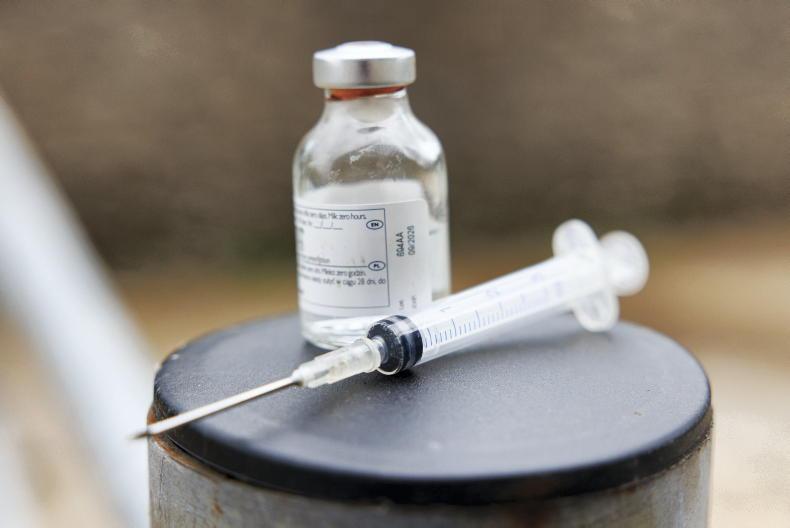

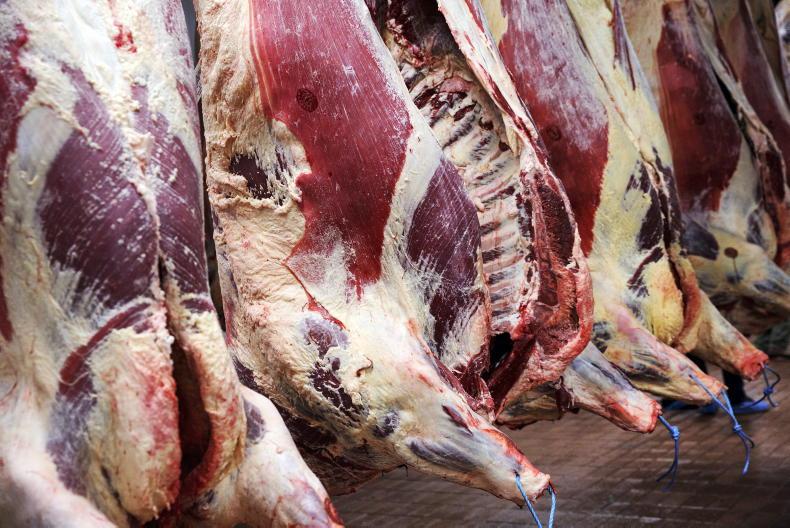
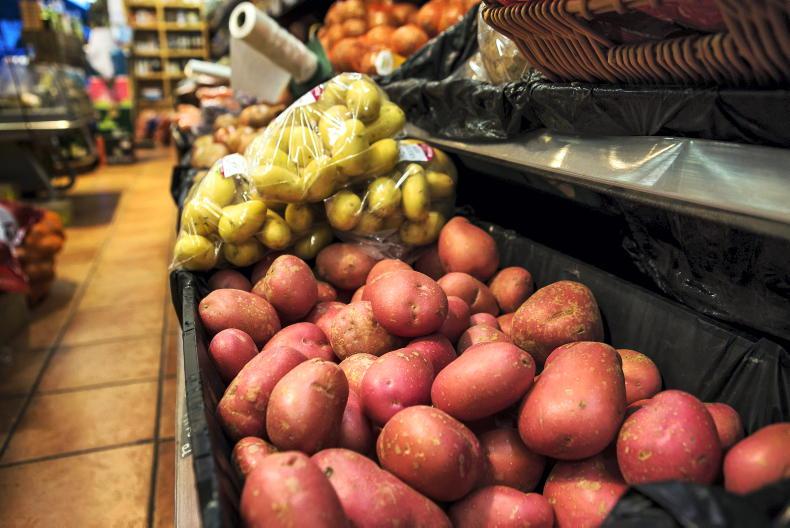
SHARING OPTIONS